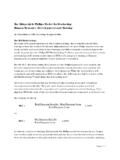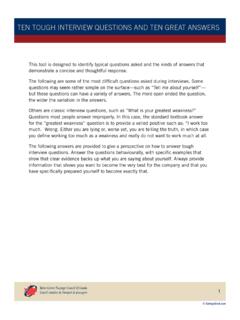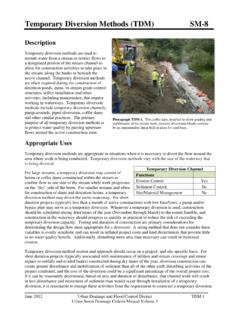Transcription of The Kirkpatrick/Phillips Model for Evaluating Human ...
1 The Kirkpatrick/Phillips Model for Evaluating Human Resource Development and Training By Allan Bailey, CEO, Learning Designs Online The ROI methodology Because of its appropriateness to the business setting, the evaluation Model that emerged from the work of Dr. Donald kirkpatrick and Dr. Jack phillips has become the most credible and most widely used training and HRD evaluation methodology in the world. In particular, the phillips ROI MethodologyTM offers a practical way to forecast the potential payoff return on investment (ROI) of a proposed training or Human resources development initiative before funds are committed. The MCPCC ROI Forecasting Tool, based on the phillips approach, is an easy-to-use decision support tool that allows organizations to quickly develop and examine the business case for investing in workforce development.
2 While the tool itself is a self-contained and self-explanatory ROI calculator, the following is a brief overview of the ROI MethodologyTM underlying the forecasting tool. ROI and cost-benefit analysis are familiar decision-making tools used in business management worldwide. They are used most commonly to analyze planned investment decisions for the acquisition of capital equipment and technology. At its simplest, ROI is the ratio of the net benefits of an investment compared to its total costs. The formula for ROI is: ROI = Total Program Benefits Total Program Costs Total Program Costs x 100% or, ROI = Net Program BenefitsTotal Program Costs x 100% In order to conduct a training ROI analysis, the phillips Model recommends an 18-step process that systematically progresses through the key evaluation/development steps from needs assessment through program objectives development, evaluation strategy, Page | 1 evaluation instrument design, data collection, analysis, return on investment calculating, and reporting.
3 The phillips Model The phillips Model measures training outcomes at five levels: Level Brief Description 1. Reaction, Satisfaction, & Planned Action Measures participant reaction to and satisfaction with the training program and participant s plans for action 2. Learning Measures skills and knowledge gains 3. Application and Implementation Measures changes in on-the-job application, behaviour change, and implementation. 4. Business Impact Measures business impact 5. Return on Investment (ROI) Compares the monetary value of the business outcomes with the costs of the training program Chain of Impact Ideally, when a training program is implemented, according to phillips , it should create a chain of impact at several levels beginning at Satisfaction/Planned Action and ending in ROI.
4 When business results and ROI are to be measured (Levels 4 & 5), it is also important to evaluate the other levels. A chain of impact should occur through the levels as skills and knowledge learned (Level 2) and are applied on the job (Level 3) to produce business impact (Level 4). If measurements are not taken at each level, it is difficult in the end to conclude that the business results achieved were actually caused by the program. On the other hand, if a negative ROI results from the training investment, the evaluator should be able to identify which link(s) in the chain was (were) broken ( , the participants did not learn (Level 2), or they were unable to successfully apply the new learning on the job (Level 3).)
5 From the perspective of the organization, the value of the information gathered increases with movement along the chain of impact from Level 1 (Reaction, Satisfaction, and Planned Action) to Level 5 (ROI). The following provides a summary of the five levels: Level 1 - Reaction, Satisfaction, and Planned Action: Level 1 measures participants satisfaction with a program as well as their plans to use what they have learned. Although most organizations evaluate at Level 1 exclusively, it should be noted that this level of evaluation does not guarantee that participants have learned new skills or knowledge or will use them on the job. Level 2 Learning: Using tests, skill practices, role playing, simulations, group evaluations, and other assessment tools, level 2 evaluations assess how much participants have Page | 2 learned.
6 Again, although it is useful to know that participants have absorbed the new skills and knowledge, a positive outcome here does not mean that participants will use the new learning when they are back on the job. Level 3 - Behaviour, Application and Implementation: Level 3 evaluation assesses whether (and how much) participants applied the new knowledge and skills on the job. The extent to which the new learning is applied in the workplace (or changes behaviours) determines Level 3 success. Here too, it should be remembered, a favourable Level 3 evaluation does not guarantee that business outcomes will be positive. Level 4 - Business Impact: Level 4 measures the extent to which business measures have improved after training.
7 Typical Level 4 measures are output, quality, costs, and time. It is important to go beyond Level 4 business results, however, because even if the training program results in substantial business improvement, there is still a concern that the program s costs may outweigh its business benefits. Level 5 - Return on Investment (ROI): ROI is the ultimate level of evaluation. It compares the monetary benefits from the program with the program costs. Although the ROI can be expressed in several ways, it is usually presented as a percentage or cost/benefit ratio. ( phillips 2005) The phillips Model evolves from, and can be distinguished from, the earlier kirkpatrick Model by the adoption of return on investment to yield additional, critical insight.
8 ROI allows decision makers to compare the ultimate value of a training investment with other potential investment opportunities. Isolation techniques: Another key technique introduced by phillips is Isolation. In the past, a major barrier to Evaluating the business impact of training was the perception that it is all but impossible to separate training s impact from the many other potential factors driving bottom line results. An important feature of the Dr. phillips evaluation Model , therefore, is the recognition that credibility depends on the extent to which the evaluation accounts for these other factors. The phillips Model uses ten techniques to isolate the business impact of training from other potential sources of business improvement (interest rate changes, competitive environment, marketing programs, employee bonus schemes, seasonal effects that temporarily contribute to business improvements, etc.)
9 Intangibles: A further refinement by phillips to the kirkpatrick Model is the addition of intangibles. According to the methodology , it is important to recognize that some outcomes cannot be easily measured and converted to monetary values. Attempting to put a dollar value on outcomes such as customer satisfaction, a less stressful work environment, and employee satisfaction can be extremely difficult, and the results may be of questionable value. Trying too hard to attach a business value may call into question the credibility of the entire evaluation effort. As a result, the phillips Page | 3 Page | 4 methodology recommends that evaluators do not try to convert those soft business measures, and instead report them as intangible benefits along with the hard business improvement outcomes such as increase in sales, reduced defects, time savings, etc.
10 The ROI Evaluation Process It worthwhile noting that evaluation may serve a number of key quality control functions in addition to establishing training s business value. Some of the other objectives of evaluation are to: improve the quality of learning programs determine if a program meet its objectives identify potential strengths and weaknesses in the learning program develop a cost/benefit analysis of training and an Human Resources Development (HRD) investments support marketing of training or HRD programs determine a program s appropriateness for the target audience assist in decision making about program investments and establish funding priorities Page | 5 Figure 1.






